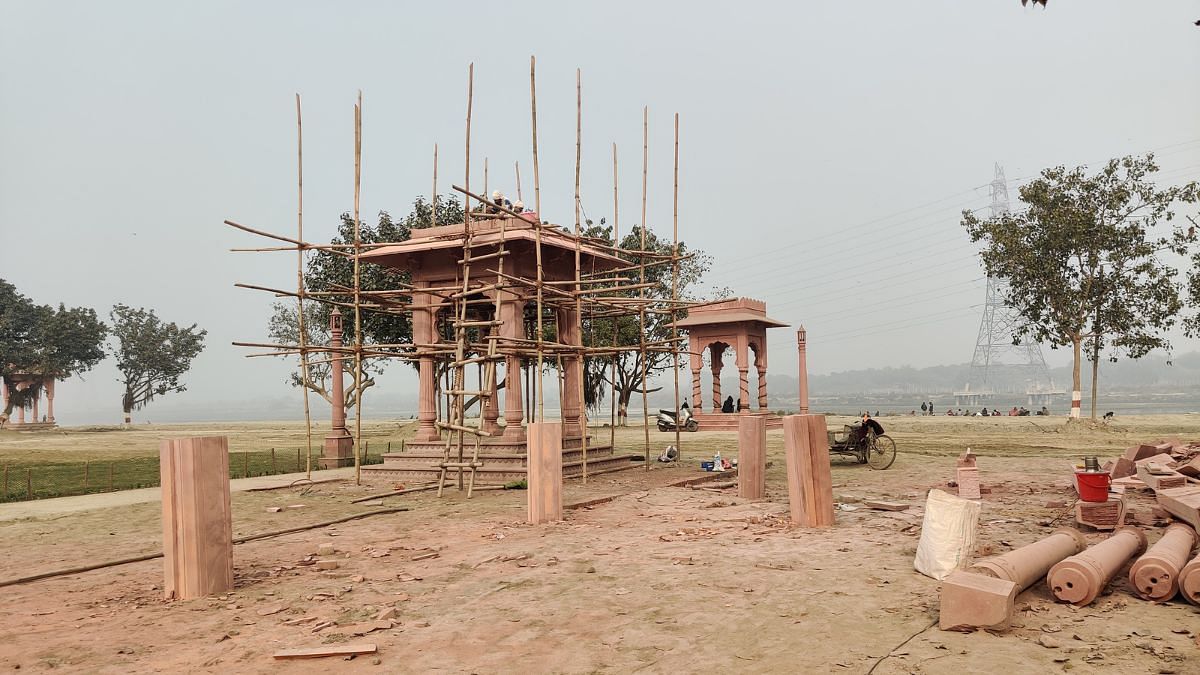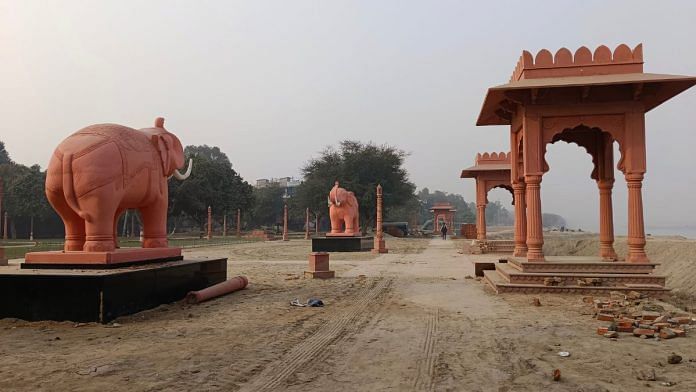New Delhi: Delhi’s long-ignored and filthy river Yamuna is getting ready for a grand religious ritual. Even before it is cleaned up. Religious fever gripping India can’t wait for swachh campaigns that take decades to clean river water but never really start off.
Two red sandstone elephants, a 300-kg bell and a Ram temple replica have already arrived at the Vasudev ghat of Yamuna near Kashmere Gate in the run up to the plan to hold grand aarti on the banks – along the lines of Haridwar, Rishikesh and Varanasi. Workers are constructing a grand flight of stairs, mini gardens and a gateway. But the makeover can’t hide the garbage and industrial effluents that float by on the Yamuna’s thinning shallow surface.
“At this point, what Yamuna needs the most is a proper and systematic cleaning process and not an aarti,” Yamuna activist Vimlendu Jha told ThePrint. “Every government talks about this issue but till date nothing has been done or worked on ground. Any puja or aarti is performed in a river and not in a drain. Right now, Yamuna is a complete drain. The first need is to convert this drain into a river.”
The question of chronology – clean the river or make it a living river – is fair but has been a non-starter.
Decades of community mobilising, cleaning activities, committees and recommendations later, neither the authorities in Delhi nor the river activists have been able to get a fix on reviving the Yamuna. Now, as Modi government doubles down on developing riverfronts and temple economies across Indian cities, Delhi’s Yamuna too is poised for a grand makeover.

Also read: Tourists in Pench aren’t just looking for tigers–now, they’re looking up at the stars
Choosing beautification over cleanliness
A car stops at the Yamuna Bridge. A man gets out of it, looks to his left and right, takes out a blue garbage bag from his car and drops it straight in to the river. It’s quite a common sight.
Yamuna is one of the most sacred rivers of India. According to Hindu mythology, the river is considered and worshiped as Goddess Yamuna, daughter of the Sun God, Surya, and sister to Yama, the God of Death. But recent generation’s memories of the river being used as place of worship is limited to Chhhath devotees standing knee-deep in the toxic foam that’s generated due to high phosphate levels, every year. “Therefore, at first the government should think about a systematic way of cleaning a river,” said Vimlendu.
A pet project of Delhi Lieutenant Governor V.K. Saxena, the plan to redevelop Vasudev Ghat is being led by the Delhi Development Authority (DDA).
Earlier known as Qudsia Ghat, the Vasudev Ghat is being developed between Wazirabad and the Old Railway Bridge on the western bank of the river. Work started in 2023 but was disrupted due to the Yamuna floods before it was resumed in December, said Ashok Bharti, one of the workers at the site.
L-G Saxena participated in a religious programme at Vasudev Ghat on the evening of 22 January and offered prayers before the replica of the newly built Ayodhya Ram Mandir on the bank.
Passing through the decorations of lamps and lights, L-G Saxena went near the massive bell, ringing it amid the sound of shankha, mantras and Jai Shri Ram chants. The L-G worshiped the replica of the Ram temple and the puja ended in prasad distribution to the crowd gathered there.
The authorities plan to build staircases facing the river so that people can enjoy the view. Apart from the bell installed at the entry gate to the ghat, there are several mandaps dotting the bank (pavilions). According to officials, the ghat aarti will start in about two to three months.
“Several mini gardens will be developed here where people can sit and rest. Walking paths will be decorated with flowers. The whole ghat will look totally different once the project is complete,” said a worker on the condition of anonymity.
I will join both the evening and morning aartis, it will be a really nice experience for Delhi people,” said 65-year-old Sukhwara who lives near the Vasudev Ghat.
Also read: A professor is fighting DU casteism. She runs a street classroom clutching the Constitution
The politics of river
Religious rituals often coincide with hygiene and cleanliness, which keep the spirit of puja sacred. But watching the black water, garbage on the banks and the stench that forces you to cover your nose, the Yamuna Ghat aarti seems to be a rush project.
“The water has been like this for a very long time. Maybe the cleaning process will start soon once the aarti date is declared,” Sukhwara told ThePrint.
The Najafgarh drain is the first major polluter that joins the Yamuna at Wazirabad in Delhi, and is known to contribute the maximum to the river’s pollution load.
“Puja or aarti is performed in the river and not in any drain. Right now, Yamuna is completely a drain. Therefore, the first need is to convert this drain into a river and then we can think about an Aarti,” said Vimlendu.
Save the rivers campaign — be it their inter-linking, or cleaning to give them the Thames look — has been a long unfinished project in Indian politics. Civic infrastructure topped with a tinge of religion is unlikely to change the waters. Even VVIP ghats of VVIP constituencies such as Banaras don’t change the fate of the rivers.
Delhi’s chief minister Arvind Kejriwal had announced a six-point action plan on 18 November 2021 to clean the river by February 2025. The plan comprises the construction and upgrade of STPs, 100 per cent sewer connectivity, desilting of the sewer network, trapping drains from JJ clusters, controlling industrial pollutants and diverting polluting drains and sub-drains.
He had said the waste water from four major drains falling in the Yamuna — Najafgarh, Badshahpur, Supplementary and Ghazipur — is being treated in-situ.
“Kejriwal has only made promises but whatever work has been done (on Gita Ghat) is because of the Modi government and L-G Saxena,” said Agasten, a truck driver who lives near Vasudev Ghat.
The AAP government also promised to shut down the industries discharging waste into the Yamuna.
“When I came to Delhi 30 or 40 years ago, Yamuna was not so dirty. Earlier, its water was quite clean, we even used to drink its water. But as the population increased, Yamuna became dirtier and dirtier,” said Agasten, 68.
Also read: Gujarat’s true crime drama—flying gold coins, fleeing labourers, police chase, & an alert ASI
‘Yamuna needs PM, just like Varanasi’
“Rivers are our cultural heritage and if the aarti starts in Yamuna like Ganga, then people will definitely be conscious to keep it clean, because when people start attending the arati and worshiping it, they will definitely think before littering it,” said VHP member Subodh Kant.
But if ghats in Varanasi are any indication, Kant’s rationale doesn’t hold true. Assai and Varuna in Varanasi are examples that prove even fear of the gods can’t keep the water clean.
Arvind Kejriwal hosted and conducted the first Yamuna Aarti at Gita Ghat in 2015.
“We will revive Yamuna within five years and I promise to promote the culture and heritage of Delhi’s mother and main water source, River Yamuna,” the Delhi CM said.
“We do not know much about it but if the aarti starts, it will be a very good initiative to make people aware and we will definitely join this initiative,” said Subodh.
And there is excitement on the ground with people already visiting Vasudev Ghat, taking selfies near the mandaps and the replica of Ram Mandir.
“I have been engaged in cleaning the Ganga for the last ten years, and I have seen that whenever aarti is performed for any river, more and more people join it and worship it and people develop the feeling of keeping it clean. Just as the aarti of Varanasi gives people a feeling of keeping the Ganga clean. When the aarti starts in Yamuna too, people will definitely keep it clean,” said Rajesh Shukla who lives on Manikarnika Ghat in Varanasi and is a province convenor in the Namami Gange project.
The image of Modi performing aarti in Varanasi also defines the cleanliness resolve the constituency has taken. Yamuna is waiting too.
“Na mein yaha aaya hu na mujhe kisi ne bheja hai, mujhe to maa ganga ne bulaya hai’ (Neither have I come here, nor has anyone sent me, Mother Ganga has called me)—by saying this and with his flagship Namami Gange programme, PM Modi gave a huge message to the public to keep the river clean. Similarly, if PM Modi joins the Yamuna Aarti and gave a message from there than nothing can be bigger than this. And also if the Yamuna remains clean, Ganga will also remain clean because both meet in Prayagraj,” said Shukla.
“Every river meets each other at some point. So if we are cleaning one river we can save many,” he added.
(Edited by Anurag Chaubey)



